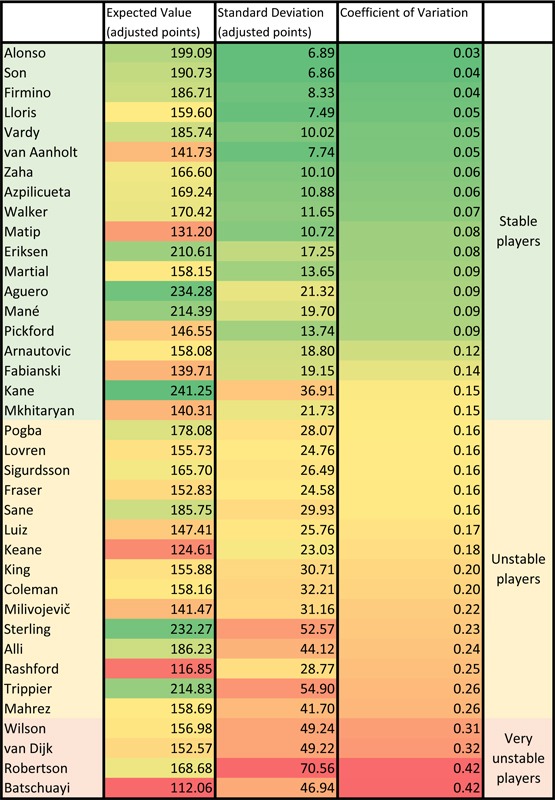I tried to find players whose points from ends of previous three seasons had very low volatility.
I made a research. I took players who scored more than 3,8 points per match in the last season and who played regularly for their team. I examined their points from previous three editions of Premier League. For example, Azpilicueta scored 170 points in 16/17, 175 in 17/18 and 158 points in 18/19 season. These numbers are very close to each other and we can assume that in the next season Azpilicueta will score similar number of points. In order to take injuries into account, I divided points by the number of matches, that a player played, and then multiplied it by 38. Azpilicueta played 38 matches in 16/17, 37 in 17/18 and 38 in 18/19 season. Based on this, adjusted points from last seasons for Azpilicueta are: 170 in 16/17, 179,83 in 17/18 and 158 in 18/19.
Then I calculated an Expected Value (mean) of adjusted points and a Standard Deviation for selected players. For Azpilicueta, the Expected Value from (170; 179,83; 158) is 169,3 with the Standard Deviation of 10,88.
In order to consider differences in Expected Values (means) of adjusted points of all players, I calculated a Coefficient of Variation for every player. The Coefficient of Variation is just the Standard Deviation divided by the Expected Value. For Azpilicueta, it is 10,88/169,24=0,06. The lower the Coefficient of Variation, the lower the dispersion of player’s adjusted points around the mean. Basically, a low value of the Coefficient of Variation means, that a player has been regularly scoring very similar number of points during last three seasons. It could help you with your FPL forecasts because a player who has a very low Coefficient of Variation will more likely score points close to the Expected Value in the upcoming season (if he plays all 38 matches, of course. You can adjust the Expected Value and multiply it by a percentage of matches you expect player to play in the next season).
In the table below, there are results from my research. Players are sorted by the lowest value of the Coefficient of Variation.
Based on this table, I divided players into three groups.
Players with stable adjusted points.
The Coefficient of Variation of these player is in range 0-0,15. Every one of these players scored very similar number of adjusted points in all three seasons. It means, that we can expect that player’s points in the upcoming season will be very close to its Expected Value (if he plays all 38 matches). When you buy these players, you buy them with some certainty that their points will not be very different from the mean. The upside is that the player’s points in the upcoming season likely will not be much lower than the Expected Value. The downside is that it much likely will not be much higher than the Expected Value either. So, when you buy these players, you buy certainty with them, that they will score very close to their Expected Value – no less, no more.
Players with unstable adjusted points and players with very unstable adjusted points.
Points of players from these two groups have been very volatile. It means that they are able to score much more than the Expected Value, but also much less. When you buy them, you buy the risk with them too. The risk that their points will be much different than the Expected Value (it may be different in both directions).
Conclusion
Now, it is up to you which players (stable/unstable) you are going to pick. If you have an aversion to the risk, you are probably going to pick many players from the first group (stable players). If you like risking, you may focus on players from the other groups. Or you can choose a middle path and diversify your team. If you want, you may read my other article related to the diversification and risk management in FPL here.
Source: SMEJKAL Vladimír, Karel RAIS. Řízení rizik ve firmách a jiných organizacích. Praha : Grada Publishing, 2006. ISBN 80-247-1667-4.



![3 Best Captain Picks for FPL GW38 [Captaincy Index] fpl best captain picks](https://www.fantasyfootballreports.com/wp-content/uploads/fpl-best-captain-picks.jpg)

